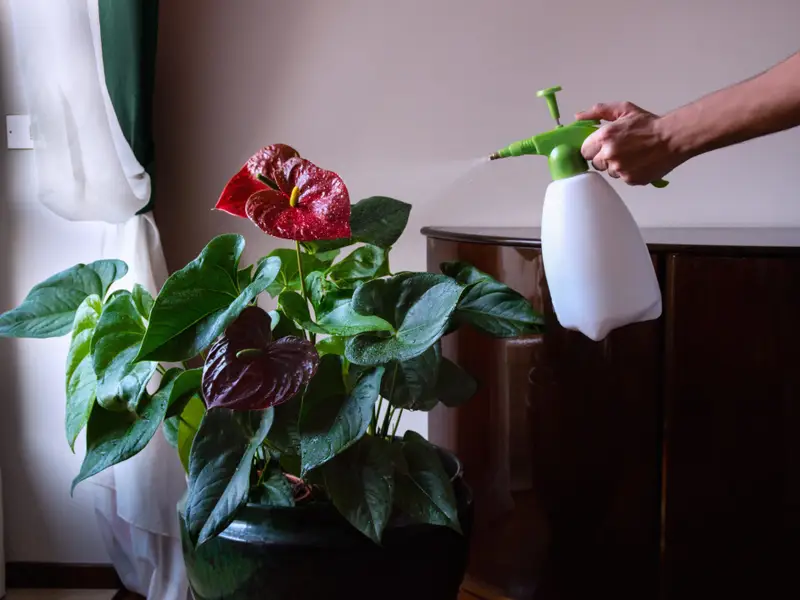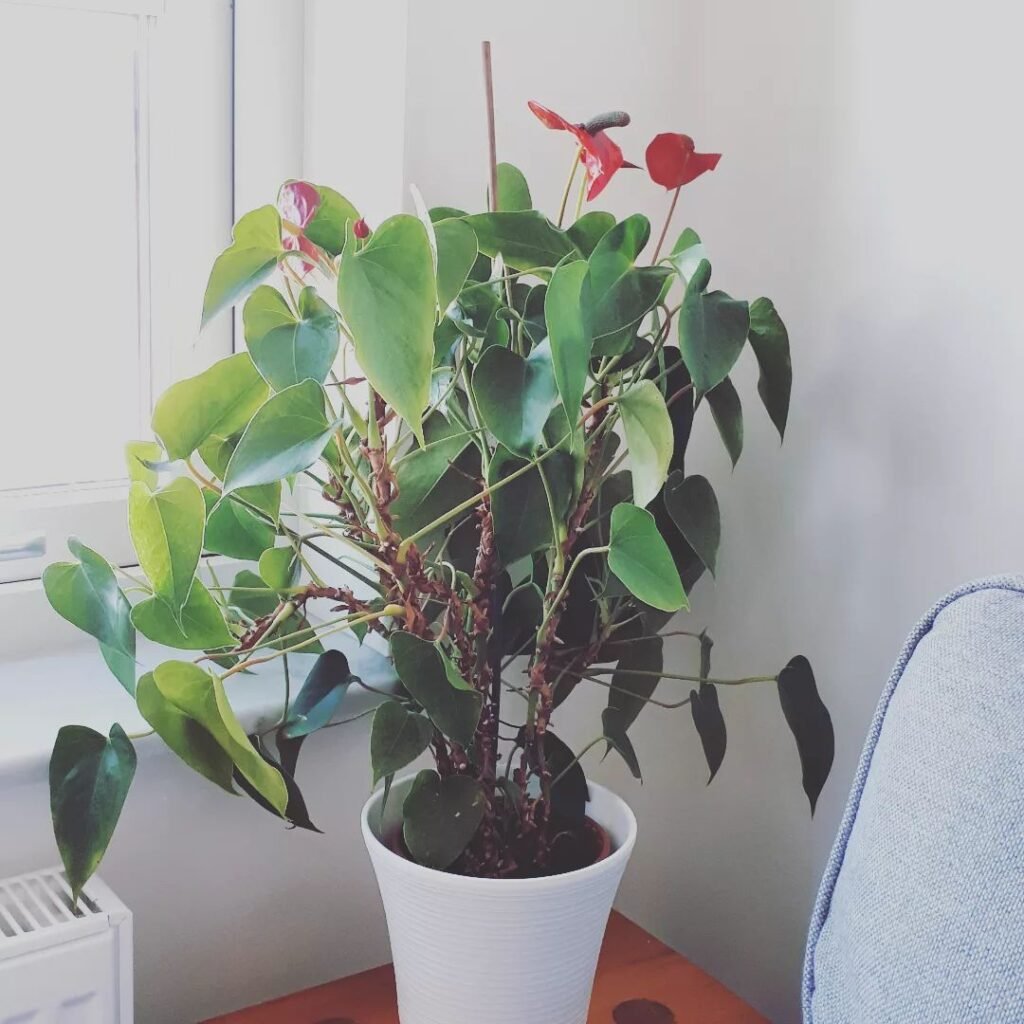Learn how to care for the exotic-looking anthurium besseae plant at home! Get tips for providing the proper light, water, humidity and soil to cultivate those spectacular crimson red blooms indoors.
If you’re looking to add some serious tropical vibes to your houseplant collection, it’s hard to beat the brilliantly colored anthurium besseae. With its dark green, velvety leaves and long-lasting crimson red spathes, this unique plant brings the beauty of the South American rainforest indoors.
Anthuriums are members of the aroid family, known for their distinctive flower shapes consisting of a fleshy spike (spadix) surrounded by a flat, modified leaf (spathe). “Painter’s Palette” is a common nickname for the besseae thanks to the multicolored contrasts between the spathe, spadix and foliage.
While they may look exotic and challenging to grow, anthurium besseae plants are surprisingly low-maintenance if you can mimic their preferred rainforest conditions. Follow these tips to enjoy these eye-catching bloomers for years to come.
Light Requirements

Native to the lower understories of rainforests, anthurium besseae thrives in bright, indirect light. Too much direct sun will scorch those velvety leaves and fade the vibrancy of the spathes. An east or northwest-facing window is ideal. You can also place them several feet back from a southern exposure.
In lower light conditions, the plants will grow more slowly and produce fewer blooms. Rotate the pot every few weeks to ensure even foliage growth. If new leaves are smaller than older ones, increase the light levels.
Besseae can be grown successfully under artificial lighting as well. Situate the plant under grow lights or high output T5 fluorescent bulbs and leave them on for 12-14 hours per day. Make sure the light source is no more than a foot or two above the top of the plant.
Water and Humidity

Like most tropical aroids, anthurium besseae need lots of humidity to thrive. Aim to maintain at least 50-60% relative humidity around your besseae at all times. Higher humidity encourages lush foliage growth and promotes flowering. Lower humidity often causes leaf edges to crisp and brown.
Run a humidifier nearby, set the plant on a pebble tray filled with water, or group your besseae with other humidity-loving houseplants. Misting the leaves can provide temporary humidity boosts, but frequent mistings may also promote fungal diseases.
Water your anthurium besseae thoroughly whenever the surface of the potting mix starts to dry out. Water until it drains completely out the bottom, then discard the excess. Pour out any water that remains in the drainage tray or saucer after 30 minutes to prevent soggy soil.
Anthuriums are susceptible to rot if the roots sit in waterlogged soil for too long. Depending on your home’s conditions, you may need to water every 5-7 days during warm months, or just once every 1-2 weeks in winter when growth naturally slows.
Temperature

Anthurium besseae are native to warm, humid rainforests so they need to be kept continuously warm between 60-90°F. Their ideal range is 65-85°F year-round. Any temperatures below 60°F will cause the plant to experience cold stress and may lead to leaf damage or dormancy.
These tropicals can’t handle freezing temperatures at all. Make sure to keep your besseae away from drafty windows, doors or air vents in winter. Those growing in cold climates will likely need to provide supplemental heat from a space heater or heat lamp to maintain optimal temperatures.
Soil and Fertilizer

Like most aroids, anthurium besseae grow best in a chunky, fast-draining potting mix. They are susceptible to fungal rots and root diseases if the soil stays waterlogged for very long. Good drainage is essential.
A mix of orchid bark, perlite, charcoal and peat moss works well, or you can use a commercial aroid potting mix. You can also create your own well-draining blend by mixing 1 part potting soil with 1 part orchid bark and 1 part perlite or pumice. Make sure the container has multiple large drain holes as well.
Feed your anthurium besseae every 4-6 weeks during spring and summer with a balanced liquid fertilizer diluted to half strength. You can use any fertilizer formulated for blooming houseplants. Reduce feedings to once every 2-3 months in winter when growth slows.
Pruning and Repotting

Anthurium besseae don’t need frequent repotting. You can leave them potbound for several years before shifting into a new container with fresh potting mix. Wait until early spring and repot every 2-3 years using a pot just 1-2 inches wider than the previous one.
These plants grow from a central crown, producing new clusters of leaves annually while shedding their oldest foliage. You can prune away any yellow or dead leaves at the base of the stalks. Cut at the base of the leaf stalk rather than in the middle.
Anthuriums bloom off new growth, so removing old spathes is not necessary. Their long-lasting blooms will persist for months before eventually turning green. The plant will naturally drop them when finished.
Propagation

One of the easiest ways to propagate anthurium besseae is by division of the mother plant. This allows you to make clones of the parent and produce more full, bushier plants from the offsets.
To divide, start by gently removing the entire rootball from the pot and brushing away any loose potting mix to expose the roots. Look for the smaller offsets growing from the main crown and rhizome. Tease them away from the mother plant using a clean, sterilized knife or shears.
Pot up each division separately in fresh potting mix, making sure each offset has its own root system attached. Keep them warm, humid and out of direct sun while the new plants establish themselves over the next few weeks.
Don’t be afraid of anthuriums that seem too exotic or challenging to grow! The dazzling anthurium besseae is a surprisingly tough, low-maintenance houseplant that delivers stunning tropical flowers year-round with the right care. Once you get the hang of its warmth, humidity and water needs, you’ll be rewarded with one of the most eye-catching blooming plants around.
Pingback: Bringing the Rainforest Home with Anthurium Bes...